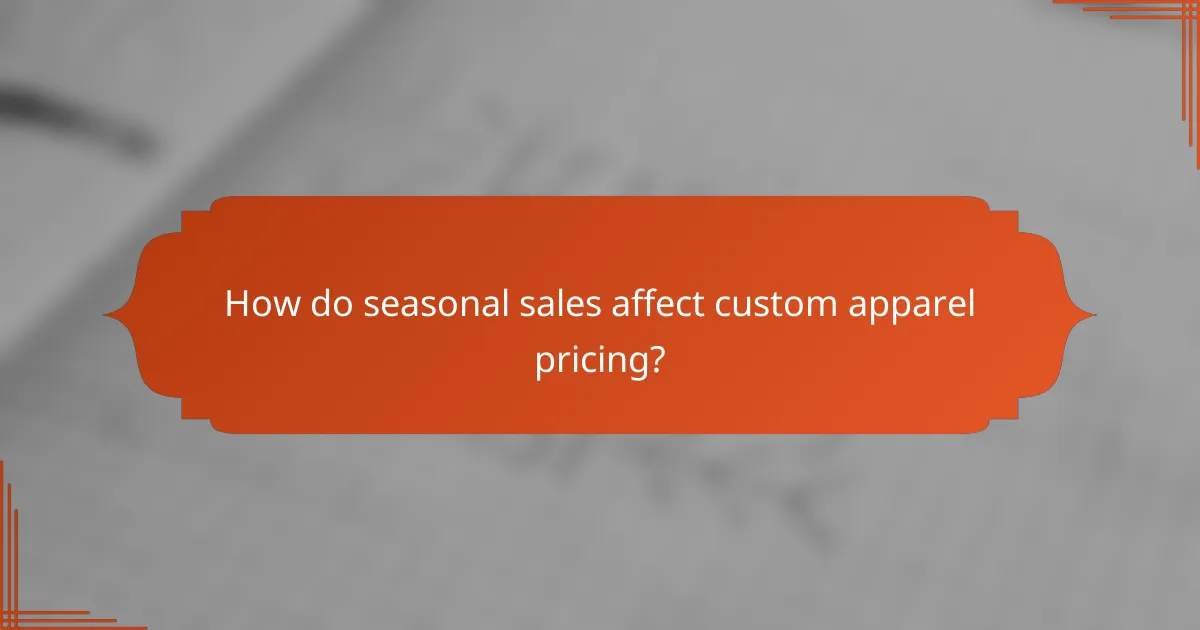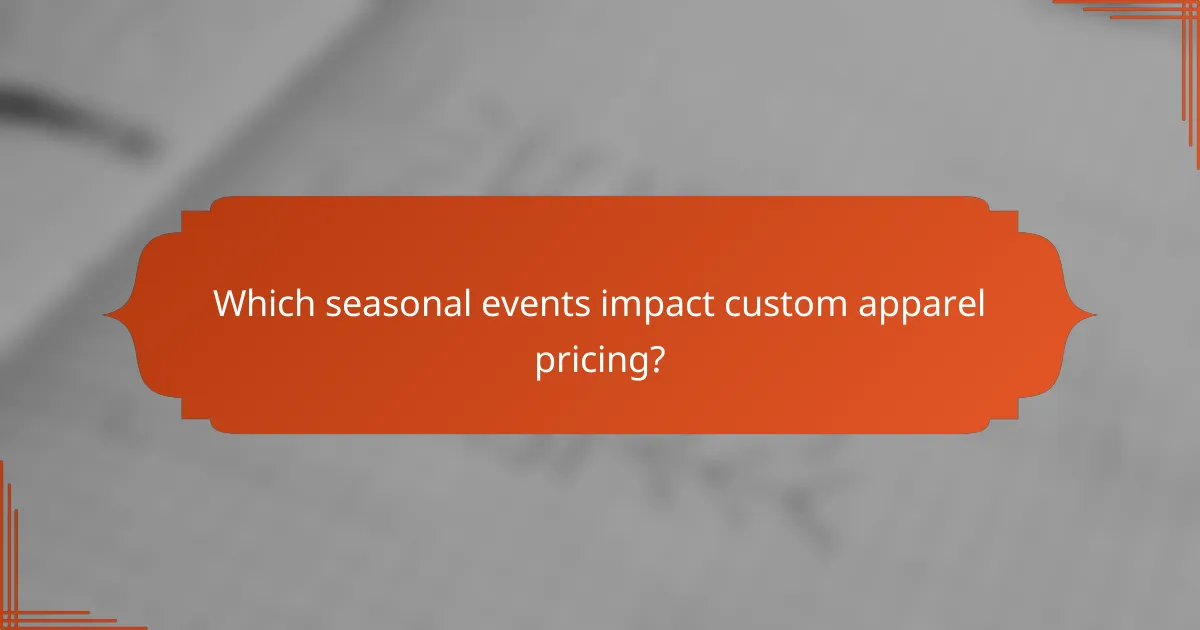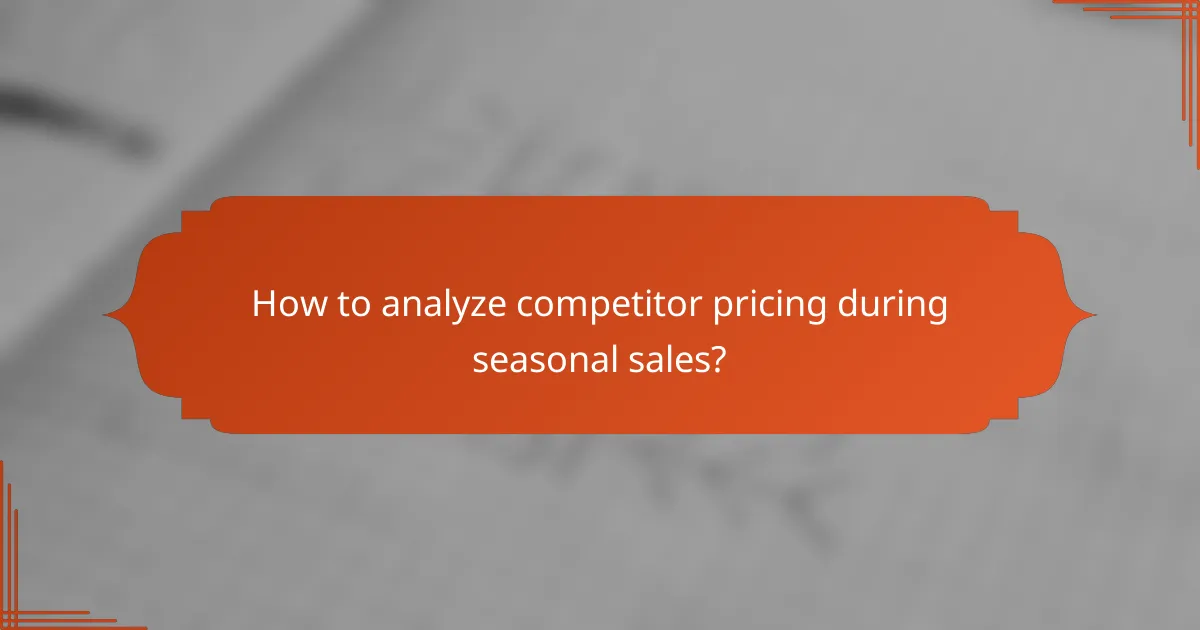Seasonal sales play a crucial role in shaping the pricing of custom apparel, as they create fluctuations in demand that influence retailers’ pricing strategies. During high-demand periods, prices may increase, while clearance events often result in significant discounts to move inventory. Understanding these dynamics allows businesses to optimize their pricing and promotional tactics effectively.

How do seasonal sales affect custom apparel pricing?
Seasonal sales significantly influence custom apparel pricing by creating fluctuations in demand and prompting various discount strategies. During peak seasons, prices may rise due to increased demand, while clearance sales can lead to substantial price reductions as retailers aim to clear inventory.
Increased demand during holidays
During holidays, such as Christmas or back-to-school season, custom apparel often sees a surge in demand. This heightened interest can lead to higher prices as suppliers capitalize on the willingness of consumers to spend more for personalized items.
For example, custom t-shirts or hoodies may see price increases of 10-30% during these peak times. Businesses should prepare for this by adjusting their pricing strategies and inventory levels in anticipation of increased orders.
Discount strategies for clearance
To manage unsold inventory after peak seasons, retailers often implement discount strategies for clearance. This can involve markdowns of 20-50% on custom apparel to attract budget-conscious shoppers and clear out stock.
Effective clearance strategies may include limited-time offers or bundling products to encourage larger purchases. Businesses should monitor sales trends closely to determine the best timing and extent of discounts to maximize revenue while minimizing excess inventory.

What are the best practices for pricing custom apparel during sales?
Effective pricing strategies for custom apparel during sales involve understanding market demand, adjusting prices dynamically, and utilizing promotional tactics. Implementing these practices can help maximize revenue while attracting customers.
Dynamic pricing models
Dynamic pricing models allow businesses to adjust their prices based on real-time market conditions, competitor pricing, and consumer demand. This approach can help optimize sales during peak seasons or special events by offering competitive rates that respond to market fluctuations.
For instance, consider using algorithms that analyze sales data and customer behavior to set prices. A common practice is to lower prices during off-peak times and increase them as demand rises, ensuring that your pricing remains attractive yet profitable.
Bundling products for promotions
Bundling products involves offering multiple items together at a discounted rate, which can encourage customers to purchase more. This strategy is particularly effective during sales events, as it enhances perceived value and can increase average order size.
For example, you might bundle a custom t-shirt with a matching cap at a reduced price compared to buying each item separately. This not only boosts sales but also helps clear out inventory, making it a win-win for both the business and the customer.

Which seasonal events impact custom apparel pricing?
Several seasonal events significantly influence custom apparel pricing, often leading to discounts or price increases based on demand. Key events like back-to-school sales and Black Friday can create opportunities for consumers and businesses alike to adjust their purchasing strategies.
Back-to-school sales
Back-to-school sales typically occur in late summer and can greatly affect the pricing of custom apparel, especially for school uniforms and branded merchandise. Retailers often offer promotions to attract parents and students, leading to price reductions of around 10-30% during this period.
When planning for back-to-school purchases, consider ordering custom apparel early to take advantage of these sales. Keep an eye on local advertisements and online promotions, as many retailers will highlight limited-time offers to boost sales.
Black Friday and Cyber Monday
Black Friday and Cyber Monday are major shopping events that can lead to substantial discounts on custom apparel. Many businesses offer promotions that can range from 20% to 50% off, making it an ideal time for bulk orders or special custom designs.
To maximize savings during these sales, create a list of desired items and compare prices across different retailers. Be aware that some companies may have limited stock or specific terms for their discounts, so act quickly to secure the best deals.

How to analyze competitor pricing during seasonal sales?
To analyze competitor pricing during seasonal sales, start by gathering data on their promotional strategies and price adjustments. This involves comparing your offerings with theirs to identify trends and potential pricing opportunities.
Utilizing pricing intelligence tools
Pricing intelligence tools can streamline the process of tracking competitor prices during seasonal sales. These tools collect data from various sources, allowing you to see how competitors adjust their prices in real-time. Look for features that provide historical pricing data and alerts for significant changes.
When choosing a pricing intelligence tool, consider factors like ease of use, data accuracy, and the range of competitors it covers. Some popular tools include Price2Spy, Competera, and Prisync, which can help you make informed pricing decisions.
Monitoring social media trends
Social media platforms are valuable for gauging consumer sentiment and competitor strategies during seasonal sales. By following relevant hashtags and competitor accounts, you can observe how they promote their sales and adjust their pricing accordingly. Engaging with customer feedback can also provide insights into pricing perceptions.
To effectively monitor social media trends, set up alerts for specific keywords related to your industry and competitors. This proactive approach helps you stay informed about shifts in consumer behavior and competitor pricing tactics, enabling you to adapt your strategies in real-time.

What are the key factors influencing custom apparel pricing?
Custom apparel pricing is primarily influenced by material costs, production timelines, and market demand. Understanding these factors can help businesses set competitive prices while maintaining profitability.
Material costs
Material costs play a crucial role in determining the price of custom apparel. Fabrics, threads, and embellishments vary widely in price, depending on their quality and sourcing. For instance, organic cotton or high-performance synthetic materials can significantly increase costs compared to standard fabrics.
When budgeting for custom apparel, consider the price range of materials. Basic fabrics may cost a few dollars per yard, while premium options can reach double digits. It’s essential to balance quality and cost to meet customer expectations without sacrificing margins.
Production timelines
Production timelines directly impact pricing, as shorter lead times often lead to higher costs. Rush orders may incur additional fees due to expedited processing and labor. Understanding the typical production schedule can help businesses plan better and avoid unexpected expenses.
For standard orders, a timeline of two to four weeks is common, while rush orders might require just a few days. Businesses should communicate clearly with suppliers about timelines to ensure accurate pricing and avoid delays that could affect customer satisfaction.

How can e-commerce platforms optimize seasonal sales for custom apparel?
E-commerce platforms can optimize seasonal sales for custom apparel by strategically planning marketing efforts and adjusting pricing to align with consumer demand. This involves leveraging data analytics to identify trends and implementing targeted promotions that resonate with customers during peak seasons.
Leveraging email marketing campaigns
Email marketing campaigns are a powerful tool for driving sales during seasonal peaks. By segmenting your audience based on past purchases and preferences, you can send personalized offers that encourage repeat business. For example, sending tailored discounts on custom apparel related to upcoming holidays can significantly boost engagement.
To maximize effectiveness, consider timing your emails to coincide with key shopping days, such as Black Friday or back-to-school season. A/B testing different subject lines and offers can help identify what resonates best with your audience, leading to higher open and conversion rates.
Implementing targeted ads
Targeted ads allow e-commerce platforms to reach specific demographics likely to purchase custom apparel during seasonal sales. Utilizing platforms like Facebook and Google Ads, you can create campaigns that focus on users’ interests and behaviors, ensuring your ads are seen by the right audience.
When setting up targeted ads, consider using seasonal keywords and imagery that reflect the current trends. Additionally, retargeting ads can remind previous visitors of your products, increasing the chances of conversion. Monitor ad performance closely and adjust your strategy based on which ads yield the best return on investment.

What are the risks of seasonal pricing strategies?
Seasonal pricing strategies can lead to several risks, including overstock issues and challenges to brand perception. Businesses must carefully balance pricing adjustments with inventory management and consumer expectations to avoid negative outcomes.
Overstock issues
Implementing seasonal pricing can result in overstock if demand does not meet expectations. When prices are reduced significantly during a season, consumers may delay purchases, leading to excess inventory that can be costly to manage.
To mitigate overstock risks, businesses should analyze historical sales data and market trends to set realistic pricing strategies. Utilizing tools like inventory management software can help track stock levels and forecast demand more accurately.
Brand perception challenges
Frequent changes in pricing can affect how consumers perceive a brand. If customers notice significant discounts during certain seasons, they may question the original value of the products, leading to a diminished brand reputation.
To maintain a positive brand image, companies should communicate the value of their apparel clearly, even during sales. Highlighting quality, craftsmanship, and unique features can help reinforce the brand’s worth, regardless of seasonal pricing strategies.

How to forecast demand for custom apparel during seasonal sales?
Forecasting demand for custom apparel during seasonal sales involves analyzing past sales trends, understanding market conditions, and considering consumer behavior. Accurate demand forecasting helps businesses optimize inventory levels and pricing strategies to maximize profits.
Analyzing historical sales data
Examining historical sales data is crucial for predicting future demand during seasonal sales. Look for patterns in sales volume, pricing changes, and customer preferences during previous seasons. This analysis can reveal which products performed well and which did not, allowing for more informed decisions.
Consider using tools like spreadsheets or specialized software to track sales data over multiple seasons. Key metrics to analyze include sales growth rates, peak sales periods, and average order values. For example, if a particular custom t-shirt design saw a 30% increase in sales during last summer’s sale, it may indicate strong demand for similar items this year.
Additionally, segment your data by demographics or geographic regions to identify specific customer trends. Understanding how different groups respond to seasonal promotions can help tailor marketing efforts and inventory management, ensuring that the right products are available at the right time.
